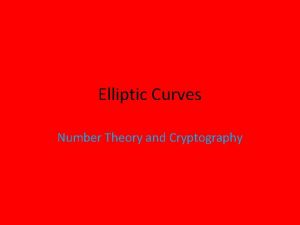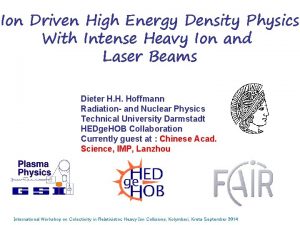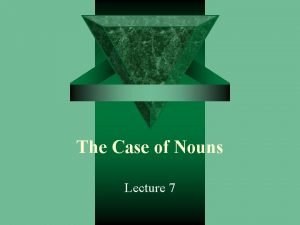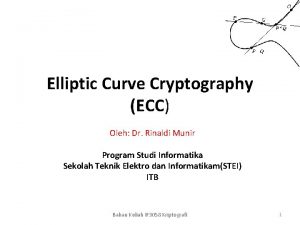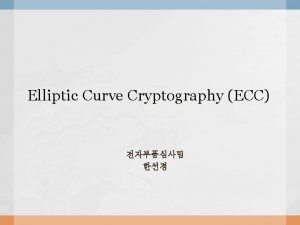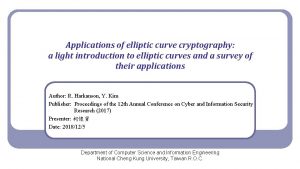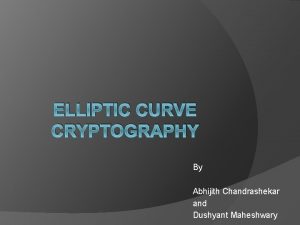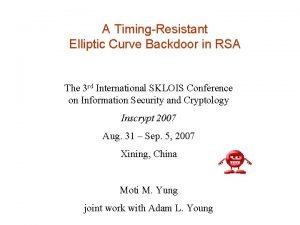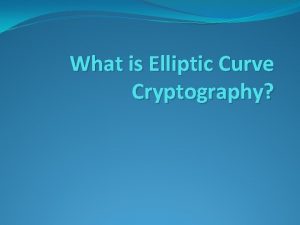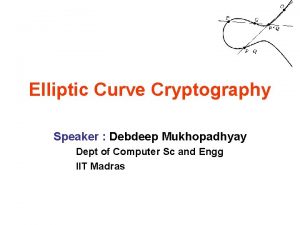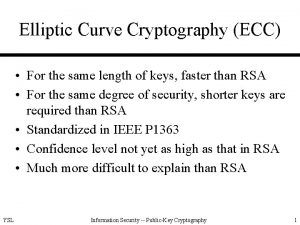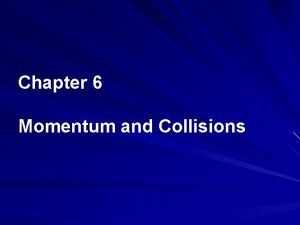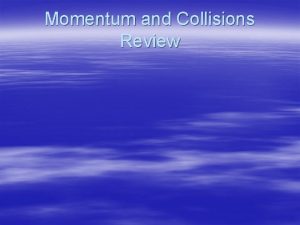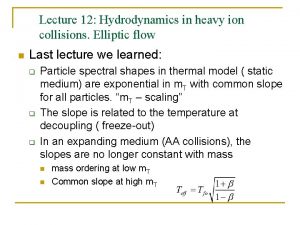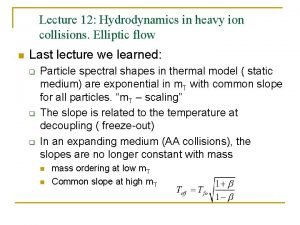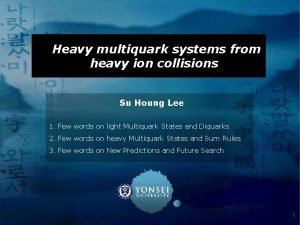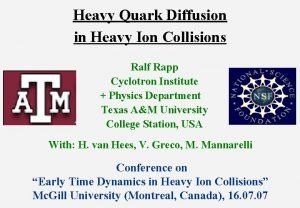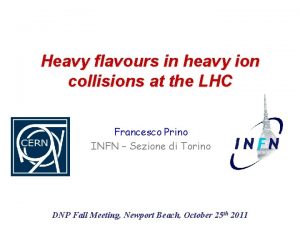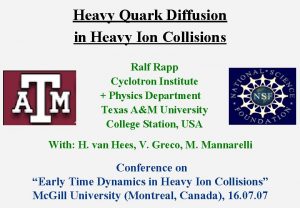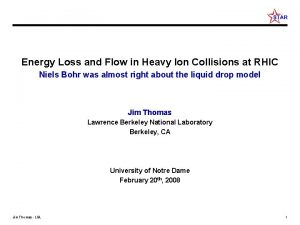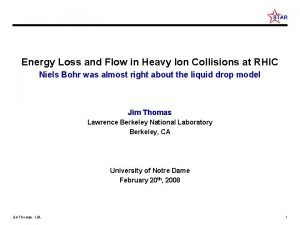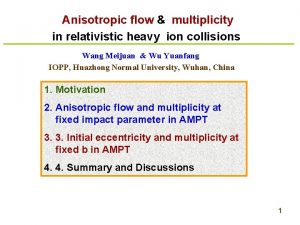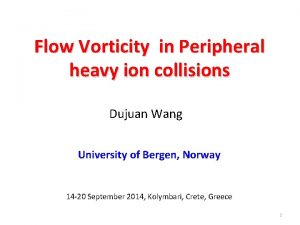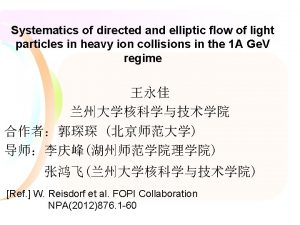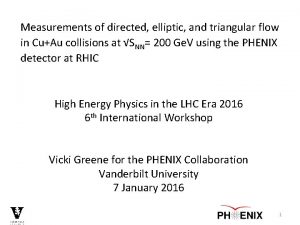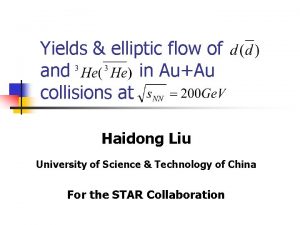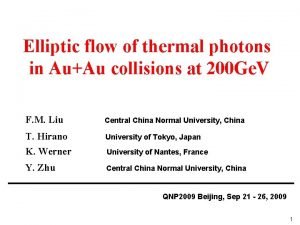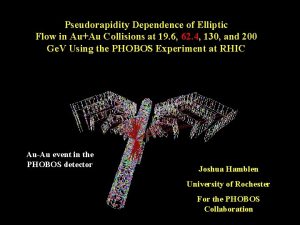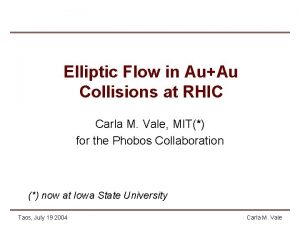Elliptic and directed flow in heavy ion collisions






















- Slides: 22

Elliptic and directed flow in heavy ion collisions Hot Quarks 2006, 16. 05. 06, Villasimius, Sardinia Hannah Petersen, Universität Frankfurt Hannah Petersen, Hot Quarks 2006

Thanks to the Ur. QMD group @ Frankfurt n n n n Mohammed Abdel-Aziz (fluctuations) Marcus Bleicher Stephane Haussler (fluctuations) Qingfeng Li (Eo. S, HBT) Diana Schumacher (dileptons) Horst Stöcker Sascha Vogel (resonances) Xianglei Zhu (elliptic flow and charm)

Outline n n n Motivation Introduction Equation of state (Eo. S) Directed flow results Elliptic flow results Summary

Motivation n No direct detection of the quark gluon plasma indirect observables like flow are needed Transverse collective flow is intimately connected to pressure n Flow is sensitive to changes in the equation of state and therefore to phase transitions phase boundary (H. Stöcker, W. Greiner Phys. Rep. 137 (1986) 277) Plot taken from H. Stöcker, E. Bratkovskaya et al. , J. Phys. G 31, 2005

Introduction - directed flow Fourier expansion of the azimuthal distribution of the emitted particles : Directed flow with measures the total amount of transverse flow Reaction plane (J. Y. Ollitrault, Phys. Rev. D, 46; A. M. Poskanzer, S. A. Voloshin, Phys. Rev. C, 58)

Introduction - elliptic flow Second coefficient of the Fourier expansion of the azimuthal particle distribution: Coordinate space asymmetry momentum space anisotropy

Time evolution §Pressure develops sharp maximum in the early stage of the reaction §Pressure gradients lead to flow §v 2 builds up directly after this maximum

Equation of state Schematic picture of the Eo. S with a first order phase transition P/e softest point HG HG Connection between pressure and flow via QGP Mixed phase e A : surface element P: pressure e: energy density

The Ur. QMD model n n n Non-equilibrium transport model All hadrons and resonances up to 2. 2 Ge. V String excitation and fragmentation Cross sections are fitted to available data, parametrized via AQM or calculated by detailed balance Generates full space-time dynamics of hadrons and strings Known event-plane

Data from C. Alt et al. , Phys. Rev. C 68, 2003 v 1 of protons @ 40 AGe. V Comparison of rapidity spectra between model and data: § Largest flow at high rapidity values § Centrality dependence visible

v 1 of protons Slope around midrapidity characterizes shape of the rapidity distribution Extracted from normalized rapidity distribution via polynomial fit At low energies: potentials are important At high energies: data developes negative slope ´wiggle´ QGP-signal? (L. P. Csernai, Phys. Lett. B 458, 1999)

Elliptic flow Two competing effects lead to different signs of v 2: Squeeze-out In-plane flow p y 2 > p x 2 > p y 2 v 2 < 0 v 2 > 0

v 2 (y) of pions @ 40/160 AGe. V Pb+Pb

v 2(pt) of pions @ 40/160 AGe. V Pb+Pb

Excitation function of elliptic flow At low energies: squeeze -out effect visible and inclusion of nuclear potential needed At high energies: underestimation of flow by calculation because of lack of pressure Data and calculation for mid-central events „HMw“= mean field from a hard equation of state with momentum dependence and mediummodified NN-cross section (Qingfeng Li, nucl-th/0602032)

‘Partonic’ dof already @ 40 AGe. V §Underestimation of v 2(pt) in model coincides with onset of ‘partonic’ matter signals onset of change of Eo. S in the early stage §´partonic´fraction is always calculated at the time of highest energy density in the reaction (see also H. Weber et al. , Phys. Lett. B 442, 1998)

Summary n n Flow is connected to pressure and therefore to the Eo. S Slope of v 1(y) becomes negative around 40 AGe. V Clear underestimation of elliptic flow at high energies in the transport model Phase transition around Elab ~40 AGe. V ?

Backup slides Hannah Petersen, Hot Quarks 2006

Elliptic flow scaling § Data shows saturation of scaled v 2 § High mass resonances like in Ur. QMD can not explain v 2 above 40 AGe. V data for h- § Strong hint for initial QGP pressure from 30 AGe. V on !

Excitation function v 2/<pt>

Model Ur. QMD

V 2(y) of protons @40 AGe. V §Experimental situation unclear §Transport model calculation is compatible with the data
 Syntax directed translation
Syntax directed translation What does ratey stand for
What does ratey stand for Elliptic curves number theory and cryptography
Elliptic curves number theory and cryptography Heavy ion
Heavy ion Elliptic genitive
Elliptic genitive Elliptic curve discrete logarithm problem
Elliptic curve discrete logarithm problem Ecdlp
Ecdlp Elliptic curve cryptography applications
Elliptic curve cryptography applications Elliptic curve cryptography
Elliptic curve cryptography Ecpvs
Ecpvs Ecc vs rsa speed
Ecc vs rsa speed Ecdlp
Ecdlp Lieberman
Lieberman Elliptic curve diffie hellman example
Elliptic curve diffie hellman example Cryptography
Cryptography Ion dipolo
Ion dipolo Ejemplo de fuerza ion ion
Ejemplo de fuerza ion ion Fuerzas dipolo dipolo ejemplos
Fuerzas dipolo dipolo ejemplos London dispersion forces
London dispersion forces A freight train is being assembled in a switching yard
A freight train is being assembled in a switching yard Types of collisions
Types of collisions A moderate force will break an egg
A moderate force will break an egg Momentum of collision
Momentum of collision


